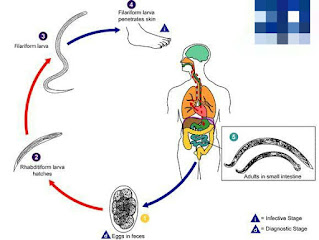Ancylostomiasis is that the name given to infection caused by the previous World hookworm Ancylostoma duodenale. Larvae that occur in contaminated soil, invade the host (man) and burrow through skin of feet into blood.
 |
| Ancylostomiasis |
Cause of Ancylostomiasis
Parasitic hookworms cause these contaminations. The two significant sorts of hookworms that cause disease are Necator americanus and Ancylostoma duodenale. Ancylostoma duodenale causes Ancylostomiasis.
The eggs of these hookworms end up on the ground in the wake of going through human defecation. They bring forth into hatchlings, which stay in the dirt until they get an opportunity to get through human skin.
Transmission of Ancylostomiasis
You can get contaminated with hookworms by coming into contact with soil that contains their hatchlings. The hatchlings enter your skin, travel through your circulatory system, and enter your lungs. They are conveyed to your small digestive tract when you hack them out of the lung and swallow. Completely developed, they can live in your small digestive system for a year or more prior to going through your defecation.
Individuals who live in warm environments in regions with helpless cleanliness and disinfection are more in danger of creating hookworm contaminations.
Diagnosis of Ancylostomiasis
Hookworm infection is diagnosed by the observation of hyaline eggs' in an exceedingly dirty smear from infected person. The observation takes place under a powerful microscope.
Symptoms
If you're generally healthy, have fewer parasite problems, and eat foods that are high in iron, you probably won't have any signs of the disease.
In the event that you do encounter manifestations, they for the most part start with irritation and are slightly ill-advised due to a hypersensitivity reaction in the place that the hatchling enters your skin. This overall comes after the run as hookworms fill up in your digestive tract. Various side effects include:
stomach torment
colic, or squeezing and inordinate crying in babies
intestinal pain
sickness
a fever
blood in your stool
a deficiency of hunger
Irritating rashes
Pathogenicity is fairly in depth involving skin, lungs and little gut. Penetrating larvae cause characteristic small and worsening sores, referred to as condensation sores or ground itch, and inflammation of skin. In lungs, migratory larvae cause petechial haemorrhages and cartilaginous tube inflammation. however greatest injury happens in intestine by the adult worms. Here, the perforated wounds still bleed for a few time in order that a lot of blood is lost than worms will consume. This leads to severe anaemia.
Anaemia, decrease normally immunity and bloody stools. internal organ wounds might cause numerous kinds of harmful infections. harmful toxins secreted by glands in head region of worms cause abdomen pain, food fermentation, diarrhoea, constipation, dyspnea, palpitation of heart, symptom, loss of health and collapse. Mental and physical growth is delayed in kids and growing youth. Patient tries to ease the epigastric pain by uptake, even dirt, thus the term 'dint eaters'. ungoverned infection might cause fatty degeneration of heart, liver and kidneys, ending in death.
Necator americanus
Nectar americanus is smaller than Ancylostoma duodenale. Adult female attains a length of 10 mm, whereas male is still shorter. Buccal capsule has a pair of ventral plates and a pair of relatively smaller dorsal plates which lack teeth, unlike Ancylostoma.
Each pair of plates presents a halfmoon appearance, hence the name semilunar plates. Besides plates, there is a dorsal Important cone and two pairs of lancets in the base of buccal capsule.
Bursa Necator is longer and narrower than that of Ancylostoma. Female Necator is capable of delivering about 15,000 eggs per day. Rest of Morphology, life cycle, diagnosis, pathogenicity, therapy and prophylaxis are similar
Source tex
Treatment of Ancylostomiasis
Treatment involves administration of medication, like dissolving agent, thymol, oil of genus Chenopodium, hexylresorcinol, etc.
most typically counseled drug is anthelminthic or blephenium attributable to its high potency and low toxicity. lately the medication for human hookworm square measure Albendazole (Zentel), anthelmintic (Mebex) Pyrantel Pamoate (Nemocid). Treatment is followed by a purge to flush out the dead worms. Iron is sometimes prescribed to beat the haemoprotein deficiency because of anaemia.
The medication of decision for the treatment of Ancylostomiasis illness is mebendazole which is successful against the two species, and likewise, will eliminate the intestinal worm Ascaris additionally, if present.
The medication is extremely proficient, requiring just a solitary portion and is modest. Be that as it may, treatment requires more than giving the anthelmintic, the patient ought to likewise get dietary enhancements to improve their overall degree of wellbeing, specifically iron supplementation is vital.
Iron is a significant constituent of a large number of chemical frameworks associated with energy digestion, DNA amalgamation and medication detoxification.
A contamination of N. americanus parasites can be treated by utilizing benzimidazoles, albendazole, and mebendazole. A blood bonding might be vital in serious instances of weakness. Light diseases are normally left untreated in regions where reinfection is normal. Iron enhancements and an eating routine high in protein will speed the recuperation process.[5] For a situation study including 56–60 men with Trichuris trichiura as well as N. americanus diseases, both albendazole and mebendazole were 90% successful in restoring T. trichiura. Nonetheless, albendazole had a 95% fix rate for N. americanus, while mebendazole just had a 21% fix rate. This proposes albendazole is best for treating both T. trichiura and N. americanus.
 |
| Ancylostomiasis Cycle |
Prevention from Ancylostomiasis
The helminthiasis is liable for respectable economic loss likewise as poor health. necessary prophylactic or preventive measures embody sporting shoes and healthful disposal of human feces in affected areas so soil might not be contaminated.
You can bring down your danger of getting contaminated by Ancylostomiasis infection:
extra protein to your eating routine.
Shop for iron enhancements.
wearing shoes when you walk outside, particularly in regions that may have defecation in the dirt
drinking safe water
appropriately cleaning and preparing food
rehearsing appropriate handwashing
In regions where Ancylostomiasis contaminations are normal, improving sterilization can decrease the quantity of diseases. This incorporates utilizing better sewage-removal frameworks and decreasing the recurrence of open air human crap.
Some agricultural countries practice preventive treatment. This includes treating gatherings of individuals who are at a higher danger of having diseases. These include:
small kids
Ladies of childbearing age
pregnant ladies
ladies who are lactating
grown-ups who work in occupations that put them in danger for substantial diseases.
Just find out :-
Malaria : types, causes and prevention
Top 3 vaccine for COVID-19 In India
Typhoid fever treatment at home



